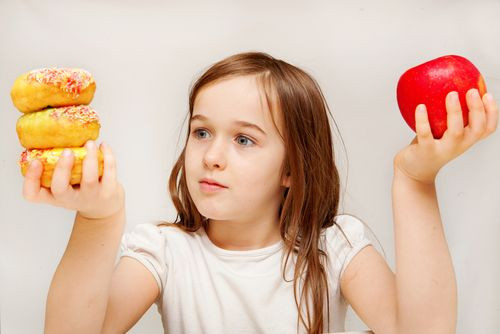Pay Kids To Eat Healthier School Lunch: Rewards Increase Consumption Of Fruits And Veggies By 80%

The phrase “eat your fruits and vegetables” is often echoed by parents during childhood years to encourage healthy eating habits at a young age. However, getting children to eat fruits and veggies could often be a burden as parents may feel their kids’ dislike for these healthy snacks seems like second nature. Now, getting kids to eat their recommended serving of fruits and veggies may have gotten a little bit easier but also a little bit sneakier. Children who are offered small monetary rewards for healthy eating increase their fruit and vegetable consumption by 80 percent, according to a recent study.
Fruits & Veggies More Matters says children between the ages of 2 and 8 years old need one to one-and-a-half cup servings of veggies and one-and-a-half cup servings of fruit per day. Kids who are fed a diet rich in fruits and vegetables are more likely to have good nutrition and physical activity. Despite the well-known documented positive health benefits of these foods, nation and state survey results based on recommendations and serving sizes reveal school-age children are not eating the amount and variety of fruits and veggies recommended.
In the U.S., people who reside in the New England states, along the Southwest, and western states typically consume the most fruits and veggies with 1.7 or greater servings per day, reports the 2013 State Indicator Report on Fruits and Vegetables. Schools, child care, and early education programs are uniquely positioned to model and reinforce healthful eating behaviors by including these foods at meals, activities and events, such as celebrations. They can also add nutrition education curricula.
In the first study published in the journal Public Health Nutrition, a team of researchers from Brigham Young and Cornell universities, observed how three schools adjusted to the new school lunch standards. These standards required a serving of fruits or vegetables on every student’s tray, whether or not the child intended to eat it. The researchers found despite the new federal rule has prompted the nation’s schools to serve an extra $5.4 million worth of fruits and veggies each day, approximately $3.8 million of that is throw in the garbage each day, according to the news release.
“We saw a minor increase in kids eating the items, but there are other ways to achieve the same goal that are much, much cheaper,” said BYU economics professor Joe Price, in the news release.
Cornell’s David Just and Price, conducted a second study to examine the effect small rewards had on fruits and vegetables consumption in the lunchroom in 15 different schools without the country’s nutrition plan going to waste. The researchers conducted week-long experiments offering either a nickel, quarter, or a raffle ticket for a larger prize to the different group of kids in these schools. The findings of this second study revealed similar results to the first study but noted fruit and vegetable consumption increased by 80 percent, while the amount of total food wasted declined by 33 percent.
When the week of prizes ended, students went back to the same level of fruit and vegetable consumption as before with no lasting improvement but with no boomerang effect either.
“Parents are often misguided about incentives,” Price said. “We feel a sense of dirtiness about a bribe. But rewards can be really powerful if the activity creates a new skill or changes preferences.”
While the kids’ motivation to eat their fruits and veggies may be misguided, it did lead to healthier food consumption in the study. In the book, Punished by Rewards, author Alfie Kohn noted prizes will prevent children from developing their own motivation to eat things that are essentially good for them. It can also lead to the boomerang effect where some children will eat less fruits and vegetables once the rewards disappear.
Now these findings have made the researchers contemplate whether they should extend the experiments over three to five weeks to see if monetary rewards yield a change in kids’ eating habits. The authors of the studies do rest assure that things do look promising.
“I don’t think we should give incentives such a bad rap,” Price said. “They should be considered part of a set of tools we can use.”
Celebrities, like Heidi Klum, have adopted the reward system philosophy to encourage healthy eating habits in her kids. Klum peels fruits to make smoothies in the morning for her kids and while some of her kids don’t love it, she decided money could be a good incentive for them to eat healthy. “…I decided I would pay them a dollar if they finish their drink. All of the money goes into their piggy banks, they have collected a bunch of money since January 1. What's good for them is good for me as well,” she said, the Daily Mail reports.
Although a monetary incentive may not be the best model approach for healthy eating habits, it can help pave the way for new and more reliable alternatives.
To learn about more ways to increase healthy eating habits in your kids, click here.
Source: Just D, and Price J. Default options, incentives and food choices: evidence from elementary-school children. Journal of Public Health Nutrition. 2013.



























